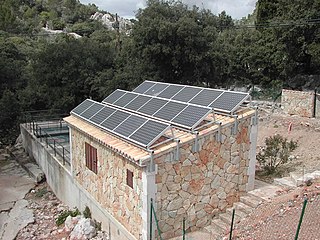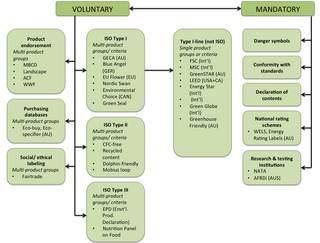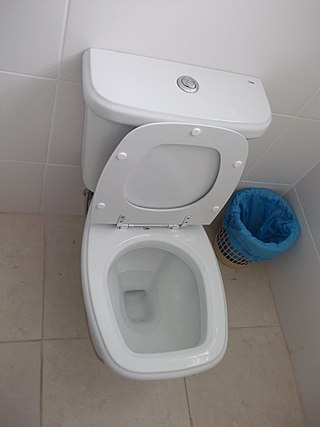
Energy Star is a program run by the U.S. Environmental Protection Agency (EPA) and U.S. Department of Energy (DOE) that promotes energy efficiency. The program provides information on the energy consumption of products and devices using different standardized methods. The Energy Star label is found on more than 75 different certified product categories, homes, commercial buildings, and industrial plants. In the United States, the Energy Star label is also shown on the Energy Guide appliance label of qualifying products.

Organic certification is a certification process for producers of organic food and other organic agricultural products, in the European Union more commonly known as ecological or biological products. In general, any business directly involved in food production can be certified, including seed suppliers, farmers, food processors, retailers and restaurants. A lesser known counterpart is certification for organic textiles that includes certification of textile products made from organically grown fibres.

The Food Standards Agency is a non-ministerial government department of the Government of the United Kingdom. It is responsible for protecting public health in relation to food in England, Wales and Northern Ireland. It is led by a board appointed to act in the public interest. Its headquarters are in London, with offices in York, Birmingham, Wales and Northern Ireland. Its counterpart in Scotland is Food Standards Scotland.

Environment friendly processes, or environmental-friendly processes, are sustainability and marketing terms referring to goods and services, laws, guidelines and policies that claim reduced, minimal, or no harm upon ecosystems or the environment.

EU Directive 92/75/EC (1992) established an energy consumption labelling scheme. The directive was implemented by several other directives thus most white goods, light bulb packaging and cars must have an EU Energy Label clearly displayed when offered for sale or rent. The energy efficiency of the appliance is rated in terms of a set of energy efficiency classes from A to G on the label, A being the most energy efficient, G the least efficient. The labels also give other useful information to the customer as they choose between various models. The information should also be given in catalogues and included by internet retailers on their websites.

Ecolabels and Green Stickers are labeling systems for food and consumer products. The use of ecolabels is voluntary, whereas green stickers are mandated by law; for example, in North America major appliances and automobiles use Energy Star. They are a form of sustainability measurement directed at consumers, intended to make it easy to take environmental concerns into account when shopping. Some labels quantify pollution or energy consumption by way of index scores or units of measurement, while others assert compliance with a set of practices or minimum requirements for sustainability or reduction of harm to the environment. Many ecolabels are focused on minimising the negative ecological impacts of primary production or resource extraction in a given sector or commodity through a set of good practices that are captured in a sustainability standard. Through a verification process, usually referred to as "certification", a farm, forest, fishery, or mine can show that it complies with a standard and earn the right to sell its products as certified through the supply chain, often resulting in a consumer-facing ecolabel.

The Carbon Trust is a United Kingdom-based consultancy established in March 2001. Its aim is to accelerate the pace of private sector Decarbonization and increase energy efficiency in the United Kingdom and worldwide.
The Nationwide House Energy Rating Scheme (NatHERS) is an Australian scheme to measure the energy efficiency of a residential dwelling. An accredited software tool assesses the home based on a variety of criteria and produces an energy star rating.

The EnergyGuide provides consumers in the United States information about the energy consumption, efficiency, and operating costs of appliances and consumer products.

An energy performance certificate (EPC) is a rating scheme to summarise the energy efficiency of buildings or devices.
Central Power Research Institute (CPRI) is a research institute originally established by the Government of India in 1960, with headquarters in Bangalore. The Institute was re-organized into an Autonomous Society in the year 1978 under the aegis of the Ministry of Power, Government of India. The main objective of setting up the Institute is to serve as a national Level laboratory for undertaking applied research in electrical power engineering besides functioning as an independent national testing and certification authority for electrical equipment and components to ensure reliability in power systems and to innovate and develop new products.
A minimum energy performance standard (MEPS) is a specification, containing a number of performance requirements for an energy-using device, that effectively limits the maximum amount of energy that may be consumed by a product in performing a specified task.
The Energy Efficiency Rating (EER) is a score applied to dwellings in the Australian Capital Territory. It ranges from zero to six system– the higher the number of stars, the better. This is mandatory for all dwellings offered for sale in the ACT.

A dual flush toilet is a variation of the flush toilet that uses two buttons or a handle mechanism to flush different amounts of water.

Green buildings in Australia are assessed and rated by a variety of government and independent ratings systems.
Environmentally sustainable design is the philosophy of designing physical objects, the built environment, and services to comply with the principles of ecological sustainability and also aimed at improving the health and comfort of occupants in a building. Sustainable design seeks to reduce negative impacts on the environment, the health and well-being of building occupants, thereby improving building performance. The basic objectives of sustainability are to reduce the consumption of non-renewable resources, minimize waste, and create healthy, productive environments.

In Australia and New Zealand, an energy rating label or energy rating is a label affixed to various appliances prior to retail sale, which allows consumers to compare the energy efficiency of product and allows consumers to know how much power a particular model will use to run. They allow consumers to compare the energy consumption of similar products, and factor lifetime running cost into their purchasing decision. The energy rating label is a mandatory comparison label under Australian regulations for store sales but not for products sold online. The label comprises an energy consumption figure for the appliance and a star rating. The energy consumption figure is an estimate of how much energy the appliance will use over a year, based on assumptions about "average usage".
NABERS, the National Australian Built Environment Rating System, is an initiative by the government of Australia to measure and compare the environmental performance of Australian buildings and tenancies. There are NABERS rating tools for commercial office buildings to measure greenhouse gas emissions, energy efficiency, water efficiency, waste efficiency and indoor environment quality. There are also energy/greenhouse and water rating tools for hotels, shopping centres and data centres.
The House Energy Rating (HER) or House Energy Rating Scheme (HERS) are worldwide standard measures of comparison by which one can evaluate the energy efficiency of a new or an existing building. The comparison is generally done for energy requirements for heating and cooling of indoor space. The energy is the main criterion considered by any international building energy rating scheme but there are some other important factors such as production of greenhouse gases emission, indoor environment quality, cost efficiency and thermal comfort, which are considered by some schemes. Basically, the energy rating of a residential building provides detailed information on the energy consumption and the relative energy efficiency of the building. Hence, HERs inform consumers about the relative energy efficiency of homes and encourage them to use this information in making their house purchase decision.
Food safety in Australia concerns the production, distribution, preparation, and storage of food in Australia to prevent foodborne illness, also known as food safety. Food Standards Australia New Zealand is responsible for developing food standards for Australia and New Zealand.












